Family Crabronidae (Bee Wolves & Sand Wasps)
The Crabronidae are a large family of wasps, including nearly all of the species formerly comprising the now-defunct superfamily Sphecoidea.
Bees and spheciform wasps, forming the superfamily Apoidea, are hugely diverse in form, size, color, and habits. The rich variety within Apoidea can make the group difficult to recognize, but most share one particular morphological trait that can reliably be used to diagnose these insects from other types of wasps. The pronotum is the first big dorsal plate on an insect’s thorax, and in apoids this plate ends at the sides in a distinctly rounded lobe that does not touch the tegula, a small plate associated with the wing base. Bees, crabronids, sphecids, ampulicids, and other spheciforms have this distinctive pronotal lobe; similarly sized and colored wasps in the Vespoidea do not.
Distribution
Worldwide.
Diversity
It collectively includes well over 200 genera, containing well over 9000 species. Crabronids were originally a part of Sphecidae, but the latter name is now restricted to a separate family based on what was once the subfamily Sphecinae. As this change is very recent, the subfamilies of Crabronidae likely will each eventually be treated as families in their own right.
The Crabronidae are currently represented by eight subfamilies in South Africa:
Astatinae
Bembicinae
Crabroninae
Dinetinae
Eremiaspheciinae
Mellininae
Pemphredoninae
Philanthinae
Biology
Solitary predatory wasps, provisioning nest with paralyzed prey for consumption by the larvae.
Links: WaspWeb
AW Insect Book: Sawflies, Wasps, Bees & Ants (Hymenoptera)
Moderator: Klipspringer
Hymenoptera Apoidea Crabronidae Bembicinae (Sand Wasps)
Subfamily Bembicinae
Mesonotum almost always expanded laterally into laminae more or less overlying the bases of the tegulae, and the jugal lobe of the hind wing is shorter than the submedian cell; all except Bembicini have two apical spurs on the middle tibiae; forewings with three submarginal cells.
Distribution
Worldwide
Diversity
The Bembicinae is a large subfamily of crabronid wasps, that includes over 80 genera in 3 tribes, and over 1800 species. Bembicines were originally a part of a single large family Sphecidae, then for many years were treated as a separate family, and recently have been placed back into a larger family, the Crabronidae this time. The different subgroups of Bembicinae are each quite distinctive, and rather well-defined, with clear morphological and behavioral differences between them.
Biology
Adults feed on nectar. Females are either solitary nest provisioners or brood parasites of other wasps. In the nest-provisioning species, each female digs one or more ground nests using mandibles and front legs (often armed with a row of stout rake spines called 'pecten'). Larvae are fed paralyzed insects which the adults put in the nests: many species prey on Auchenorhyncha but several species are kleptoparasitic on (steal from) other Bembicinae.
Links: WaspWeb; The Sand Wasps: Natural History and Behavior. Howard Ensign Evans, Kevin M. O'Neill, Howard Ensign Evans
Mesonotum almost always expanded laterally into laminae more or less overlying the bases of the tegulae, and the jugal lobe of the hind wing is shorter than the submedian cell; all except Bembicini have two apical spurs on the middle tibiae; forewings with three submarginal cells.
Distribution
Worldwide
Diversity
The Bembicinae is a large subfamily of crabronid wasps, that includes over 80 genera in 3 tribes, and over 1800 species. Bembicines were originally a part of a single large family Sphecidae, then for many years were treated as a separate family, and recently have been placed back into a larger family, the Crabronidae this time. The different subgroups of Bembicinae are each quite distinctive, and rather well-defined, with clear morphological and behavioral differences between them.
Biology
Adults feed on nectar. Females are either solitary nest provisioners or brood parasites of other wasps. In the nest-provisioning species, each female digs one or more ground nests using mandibles and front legs (often armed with a row of stout rake spines called 'pecten'). Larvae are fed paralyzed insects which the adults put in the nests: many species prey on Auchenorhyncha but several species are kleptoparasitic on (steal from) other Bembicinae.
Links: WaspWeb; The Sand Wasps: Natural History and Behavior. Howard Ensign Evans, Kevin M. O'Neill, Howard Ensign Evans
AW Insect Book: Sawflies, Wasps, Bees & Ants (Hymenoptera)
Sand Wasp Bembix sp.
Family: Crabronidae. Subfamily: Bembicinae. Tribe: Bembicini
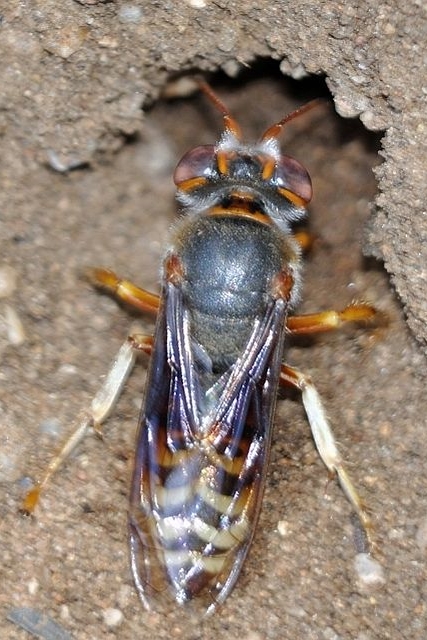 © BluTuna
© BluTuna
Kruger National Park
Bembix is a large cosmopolitan genus of medium to large, often brightly colored (often striking yellow and black-striped abdomen) predatory sand wasps. The genus Bembix may be separated from allied genera by the characters of the maxillary palpi, which are short, generally concealed and four-jointed; and by the labial palpi which are two-jointed. Ocelli vestigial; labrum elongate, beak-like, extending beyond mandibles.
Females excavate solitary open burrows in sandy soil. Nests are provisioned with flies (Calliphoridae, Muscidae, Syrphidae, Sarcophagidae, Tachinidae among various other families).
Links: WaspWeb: Genus Bembix
https://jhr.pensoft.net/article/1653/
https://www.researchgate.net/publicatio ... on_biology
Family: Crabronidae. Subfamily: Bembicinae. Tribe: Bembicini
 © BluTuna
© BluTunaKruger National Park
Bembix is a large cosmopolitan genus of medium to large, often brightly colored (often striking yellow and black-striped abdomen) predatory sand wasps. The genus Bembix may be separated from allied genera by the characters of the maxillary palpi, which are short, generally concealed and four-jointed; and by the labial palpi which are two-jointed. Ocelli vestigial; labrum elongate, beak-like, extending beyond mandibles.
Females excavate solitary open burrows in sandy soil. Nests are provisioned with flies (Calliphoridae, Muscidae, Syrphidae, Sarcophagidae, Tachinidae among various other families).
Links: WaspWeb: Genus Bembix
https://jhr.pensoft.net/article/1653/
https://www.researchgate.net/publicatio ... on_biology
Hunting cannot be considered a sport as all contestants in a sport should know they are playing the game!
AW Insect Book: Sawflies, Wasps, Bees & Ants (Hymenoptera)
Flowerpot Wasp Gorytes natalensis, Pseudoplisus natalensis
Family: Crabronidae. Subfamily Bembicinae. Tribe Bembicini
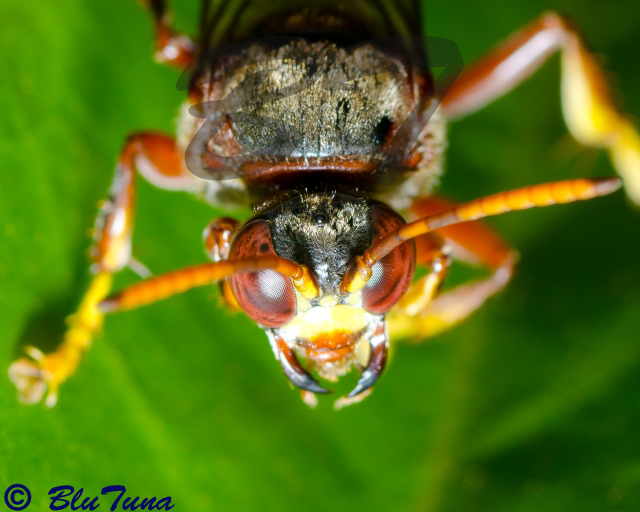 © BluTuna
© BluTuna
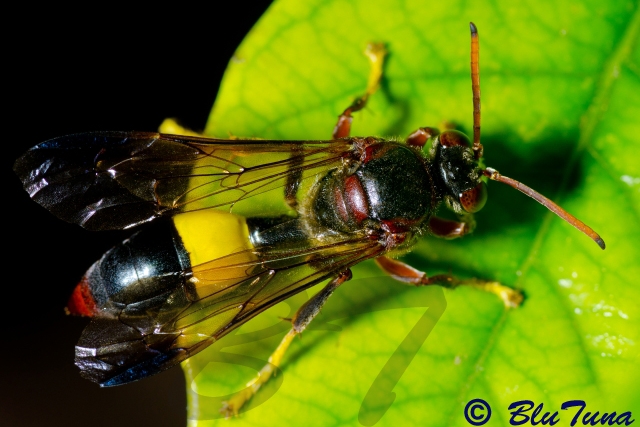 © BluTuna
© BluTuna
Garden in Johannesburg
Description
Medium-sized, body length 20 mm. Eyes strongly converging. Gaster subpendunculate. Metanotum flattened. Wings smoky hyaline.
Distribution
Southern Africa.
Biology
Gorytes natalensis is a solitary nester, nesting often in the soil in flowerpots. A predatory wasp, provisioning the nest with prey of 'Homoptera' for consumption by the larvae. Auchenorrhynchan spittlebugs in the family Cercopidae are reported as prey items.
Links: Sphecid Wasps of the World: A Generic Revision. Richard Mitchell Bohart, Arnold S. Menke; WaspWeb - Bembicini
Family: Crabronidae. Subfamily Bembicinae. Tribe Bembicini
 © BluTuna
© BluTuna © BluTuna
© BluTunaGarden in Johannesburg
Description
Medium-sized, body length 20 mm. Eyes strongly converging. Gaster subpendunculate. Metanotum flattened. Wings smoky hyaline.
Distribution
Southern Africa.
Biology
Gorytes natalensis is a solitary nester, nesting often in the soil in flowerpots. A predatory wasp, provisioning the nest with prey of 'Homoptera' for consumption by the larvae. Auchenorrhynchan spittlebugs in the family Cercopidae are reported as prey items.
Links: Sphecid Wasps of the World: A Generic Revision. Richard Mitchell Bohart, Arnold S. Menke; WaspWeb - Bembicini
Hunting cannot be considered a sport as all contestants in a sport should know they are playing the game!
AW Insect Book: Sawflies, Wasps, Bees & Ants (Hymenoptera)
Digger Wasp Stizus sp.
Family: Crabronidae. Subfamily Bembicinae. Tribe: Bembicini
 © BluTuna
© BluTuna
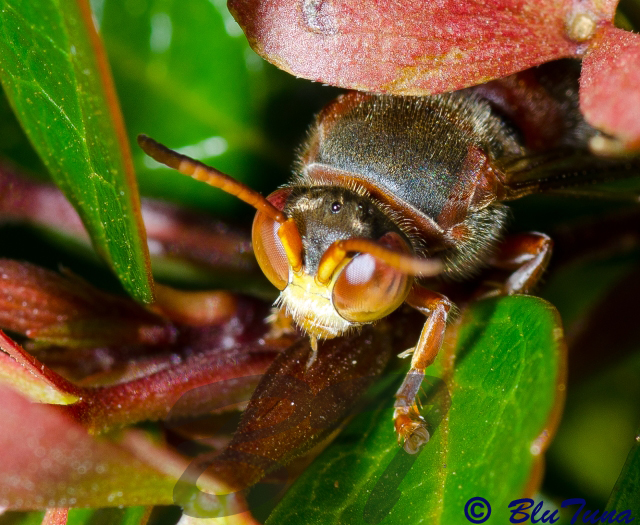 © BluTuna
© BluTuna
Garden in Johannesburg
Stizus is the third largest genus in the subfamily with more than 120 species. The genus is widesprate in temperate and tropical regions.
Wasps of this genus are stout and medium sized to large, upt to 3.5 cm in length. Often black and yellow with red markings, some are mostly yellow and a few reddish. Eyes converging slightly below. Forewing with submarginal call II open in front.
Females excavate burrows in sandy soil. One to several cells are provisioned with grasshoppers, katydids or mantids for larval food.
In newer generic classification the genus Stizus has been split into Stizus, Stizoides and Bembecinus.
Links: WaspWeb - Genus Stizus: Sphecid Wasps of the World: A Generic Revision. Richard Mitchell Bohart, Arnold S. Menke
Family: Crabronidae. Subfamily Bembicinae. Tribe: Bembicini
 © BluTuna
© BluTuna © BluTuna
© BluTunaGarden in Johannesburg
Stizus is the third largest genus in the subfamily with more than 120 species. The genus is widesprate in temperate and tropical regions.
Wasps of this genus are stout and medium sized to large, upt to 3.5 cm in length. Often black and yellow with red markings, some are mostly yellow and a few reddish. Eyes converging slightly below. Forewing with submarginal call II open in front.
Females excavate burrows in sandy soil. One to several cells are provisioned with grasshoppers, katydids or mantids for larval food.
In newer generic classification the genus Stizus has been split into Stizus, Stizoides and Bembecinus.
Links: WaspWeb - Genus Stizus: Sphecid Wasps of the World: A Generic Revision. Richard Mitchell Bohart, Arnold S. Menke
Hunting cannot be considered a sport as all contestants in a sport should know they are playing the game!
Hymenoptera Apoidea Crabronidae Crabroninae
Subfamily Crabroninae
Solitary predatory wasps, with large and quadrate head, with the inner margins of the eyes straight and converging ventrally. Forewing has only one submarginal cell.
Distribution
Worldwide.
Diversity
The subfamily Crabroninae is the most diverse group in the wasp family Crabronidae, containing about 2000 species in 107 genera, 7 tribes.
Biology
Adults commonly found on flowers. The adult females of many groups dig tunnels in the ground for nesting, but others use different techniques, including the construction of tube-like mud nests.
As with all other sphecoid wasps, the larvae are carnivorous; females hunt for prey on which to lay their eggs, supplying the larvae with paralyzed, living prey for consumption by the larvae.
Links: WaspWeb
Solitary predatory wasps, with large and quadrate head, with the inner margins of the eyes straight and converging ventrally. Forewing has only one submarginal cell.
Distribution
Worldwide.
Diversity
The subfamily Crabroninae is the most diverse group in the wasp family Crabronidae, containing about 2000 species in 107 genera, 7 tribes.
Biology
Adults commonly found on flowers. The adult females of many groups dig tunnels in the ground for nesting, but others use different techniques, including the construction of tube-like mud nests.
As with all other sphecoid wasps, the larvae are carnivorous; females hunt for prey on which to lay their eggs, supplying the larvae with paralyzed, living prey for consumption by the larvae.
Links: WaspWeb
AW Insect Book: Sawflies, Wasps, Bees & Ants (Hymenoptera)
Sand Wasp Miscophus spp. (These are different species!)
Superfamily Apoidea. Family Crabronidae. Subfamily Crabroninae. Tribe Miscophini
Members of the genus Miscophus are found in all regions except Australasia. There are about 150 species, most found in the Old World, especially the Mediterranean area. They are small to medium (2.8-10 mm), mostly somber colored with rather short wings that are usually infuscate apically (cloudy or tinged with brown at the apex).



Oct. & Nov. Kgalagadi Transfrontier Park
Biology of Miscophus
Data on typical Miscophus are for the most part fragmentary.
They resemble ants when on the ground and are often seen running about in their company. They hold their wings flat over the gaster, and the clear wing base and smokey tip in some species accentuate mimicry with the ant petiole and gaster respectively.
In general, the nesting activities of the various species of Miscophus are similar. They are ground nesters whose nests are dug in loose, sandy soil and are short, varying from 2-5 cm in length.
Small, usually immature spiders serve as larval food, and mass provisioning is the rule. Data suggests that in at least some species of Miscophus, only certain kinds of spiders are collected. The egg is laid on one of the last provisions.
Females search for prey on the ground, but there is evidence that plant dwelling spiders are also collected. She grasps the front legs of the spider with her mandibles and usually walks or makes short hopping flights to the nest.
The tendency toward reduction or loss of certain wing veins, reduction in wing cell size, and overall shortening of the wings in Miscophus are probably correlated with the habit of spending most of their time walking rather than flying, even during prey search.
Links: Sphecid Wasps of the World: A Generic Revision. Richard Mitchell Bohart, Arnold S. Menke
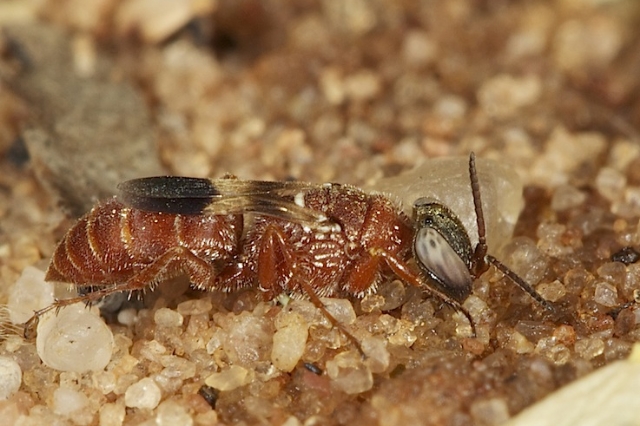

Kgalagadi Transfrontier Park
Superfamily Apoidea. Family Crabronidae. Subfamily Crabroninae. Tribe Miscophini
Members of the genus Miscophus are found in all regions except Australasia. There are about 150 species, most found in the Old World, especially the Mediterranean area. They are small to medium (2.8-10 mm), mostly somber colored with rather short wings that are usually infuscate apically (cloudy or tinged with brown at the apex).



Oct. & Nov. Kgalagadi Transfrontier Park
Biology of Miscophus
Data on typical Miscophus are for the most part fragmentary.
They resemble ants when on the ground and are often seen running about in their company. They hold their wings flat over the gaster, and the clear wing base and smokey tip in some species accentuate mimicry with the ant petiole and gaster respectively.
In general, the nesting activities of the various species of Miscophus are similar. They are ground nesters whose nests are dug in loose, sandy soil and are short, varying from 2-5 cm in length.
Small, usually immature spiders serve as larval food, and mass provisioning is the rule. Data suggests that in at least some species of Miscophus, only certain kinds of spiders are collected. The egg is laid on one of the last provisions.
Females search for prey on the ground, but there is evidence that plant dwelling spiders are also collected. She grasps the front legs of the spider with her mandibles and usually walks or makes short hopping flights to the nest.
The tendency toward reduction or loss of certain wing veins, reduction in wing cell size, and overall shortening of the wings in Miscophus are probably correlated with the habit of spending most of their time walking rather than flying, even during prey search.
Links: Sphecid Wasps of the World: A Generic Revision. Richard Mitchell Bohart, Arnold S. Menke


Kgalagadi Transfrontier Park
Last edited by ExFmem on Fri Jan 16, 2015 7:37 pm, edited 2 times in total.
AW Insect Book: Sawflies, Wasps, Bees & Ants (Hymenoptera)
Sand Wasp Miscophus kriechbaumeri
Superfamily Apoidea. Family Crabronidae. Subfamily Crabroninae. Tribe Miscophini
See previous post for general information on the genus Miscophus.
Identification of Miscophus kriechbaumeri
Two southern African species, M. bellulus (Zimbabwe), and M. kriechbaumeri have distinctive scalelike tufts of setae on the head and thorax.

Facial Portrait of Miscophus kriechbaumeri


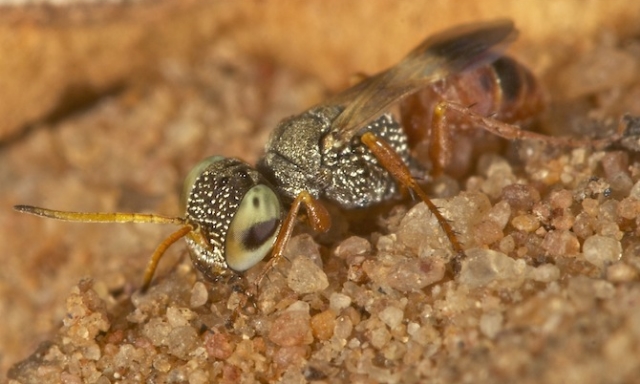
Oct. & Nov. Kgalagadi Transfrontier Park
Distribution of Miscophus kriechbaumeri
South Africa

Links: Sphecid Wasps of the World: A Generic Revision. Richard Mitchell Bohart, Arnold S. Menke
Superfamily Apoidea. Family Crabronidae. Subfamily Crabroninae. Tribe Miscophini
See previous post for general information on the genus Miscophus.
Identification of Miscophus kriechbaumeri
Two southern African species, M. bellulus (Zimbabwe), and M. kriechbaumeri have distinctive scalelike tufts of setae on the head and thorax.

Facial Portrait of Miscophus kriechbaumeri



Oct. & Nov. Kgalagadi Transfrontier Park
Distribution of Miscophus kriechbaumeri
South Africa

Links: Sphecid Wasps of the World: A Generic Revision. Richard Mitchell Bohart, Arnold S. Menke
Last edited by ExFmem on Fri Jan 16, 2015 7:38 pm, edited 1 time in total.
AW Insect Book: Sawflies, Wasps, Bees & Ants (Hymenoptera)
Sand Wasp Miscophus sp.
Superfamily Apoidea. Family Crabronidae. Subfamily Crabroninae. Tribe Miscophini
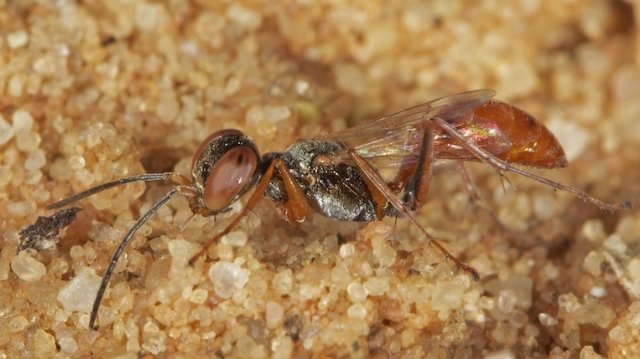


Kgalagadi Transfrontier Park
Superfamily Apoidea. Family Crabronidae. Subfamily Crabroninae. Tribe Miscophini



Kgalagadi Transfrontier Park
Last edited by ExFmem on Fri Jan 16, 2015 7:39 pm, edited 1 time in total.
AW Insect Book: Sawflies, Wasps, Bees & Ants (Hymenoptera)
Larrine Wasp
Superfamily Apoidea. Family Crabronidae. Subfamily Crabroninae. Tribe Larrini
 © BluTuna
© BluTuna
Garden in Johannesburg
Perhaps a species in the genus Liris .
Superfamily Apoidea. Family Crabronidae. Subfamily Crabroninae. Tribe Larrini
 © BluTuna
© BluTunaGarden in Johannesburg
Perhaps a species in the genus Liris .


